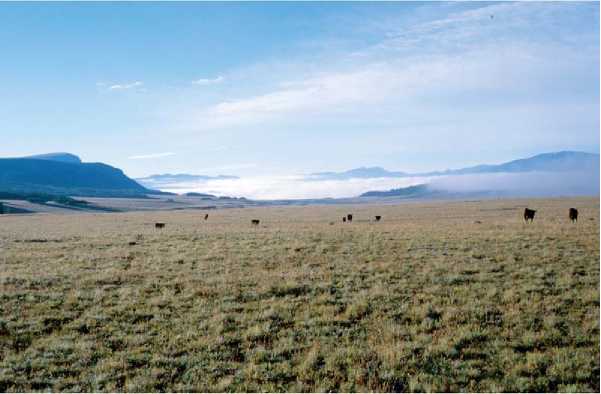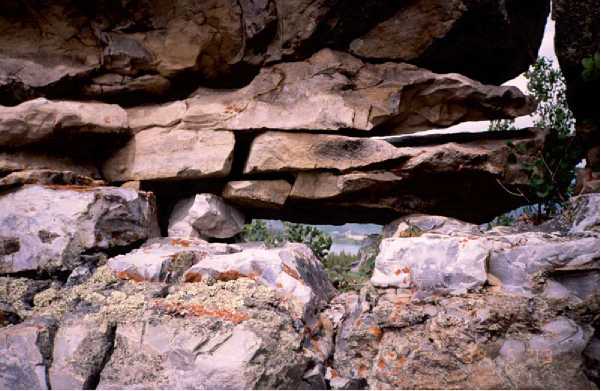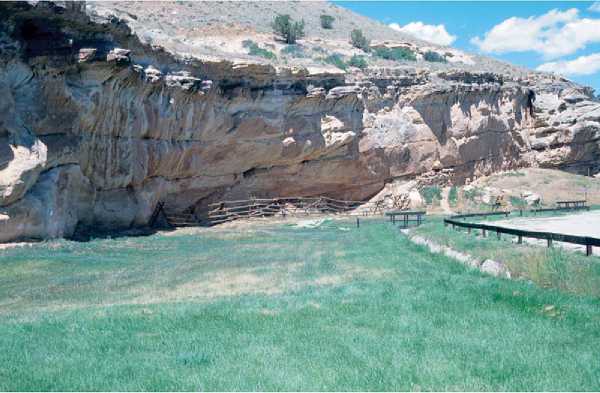Having provided a sense for the unique physiographic and environmental properties of North Americas Rocky Mountains, we turn now to archaeologists’ current understanding of when, how, and why prehistoric people occupied them.
Prehistoric Chronology and Land Use
Archaeologists have known since the 1960s, when National Park Service Archaeologist Wilfred Husted first proposed the theory, that humans have occupied the Rocky Mountains on a sustained basis for at least 10 000 years - nearly as long as people are known to have occupied North America generally. The first archaeologically recognizable North American culture, Clovis (see New World, Peopling of), penetrated the Rockies, but left only a light signature of their tenure, 11 500-10 800 radiocarbon years before present. Clovis spear points have been recovered as isolated surface finds throughout the Rocky Mountains, but Rocky Mountain Clovis sites are limited in number, type, size, and elevation (they are particularly rare in the subalpine and alpine zones, probably because some - though not all - Rocky Mountain peaks were still glacier-covered during the latest Pleistocene).
By subsequent Folsom time, 10 800-10200 radiocarbon years before present, evidence suggests that Palaeo-Americans had started to move into the Rocky Mountains on a more sustained basis. Though many archaeologists associate them intimately with the High Plains, Folsom people and their contemporaries frequently hunted bison in large Rocky Mountain parks (e. g., Figure 4), including Colorado’s Middle Park, San Luis Valley, and Gunnison Basin. A few of their kills occurred during the winter months, suggesting that some of these early occupants may have utilized the Rocky Mountains on a year-round basis. Folsom folk also occasionally camped in rockshelters in the Bighorn Mountains of northern Wyoming, and in open foothills settings farther north, in the Elkhorn Mountains of west-central Montana.
If there is any doubt as to whether or not some Folsom bison hunters utilized the Rockies on a year-round basis, there is no doubt that after Folsom time, prehistoric groups moved into this niche and never looked back. A few residential sites, most exceptionally two large rockshelters in the foothills of northwestern Wyoming - Mummy Cave in the Absaroka Range and Medicine Lodge Creek in the Bighorn Mountains - show human occupation beginning in the very early Holocene and continuing through the recent historic past. Such deeply stratified, continuously used sites have played an immeasurably important role in characterizing 10 000 years of human use of the Rocky Mountains.

Figure 4 High altitude (c. 3100 m (10170 ft) asl) mountain meadow - reasonably considered a park - in the Upper Rio Grande Basin of southern Colorado. This photograph was taken from the Black Mountain Folsom site, a hunting camp nestled today at the fringes of subalpine forest. Margaret Jodry excavated the site in the 1990s.
From approximately 10 000-7500 radiocarbon years before present, Palaeoindians utilized all environmental zones of the Rocky Mountains, exploited local Rocky Mountain stone raw materials, and manufactured spear points that differed from those of their contemporaries living either on the Plains to the east or in the Far West. In addition to hosting what seminal Central Plains and Rocky Mountain archaeologist George C. Frison has termed ‘Foothill-Mountain’ groups (year-round late Palaeo-indian residents), the Rockies were also used seasonally by lowland late Palaeoindian people needing or wanting such resources as chipped stone and groundstone raw material, vegetable and nut crops (notably pifion) that grow only in the mountains, and large game (perhaps because it is more pleasant to hunt bighorn by a columbine-ringed alpine lake than bison by a desiccated Plains playa in August). Archaeologists lack sufficient numbers of sites to offer well-substantiated models for how late Palaeo-indians moved around the mountain landscape, but available evidence suggests that like subsequent Archaic hunter-gatherers, late Paleoindians organized their mobility strategies according to seasonal constraints and resource needs of both the short and long term.
The Archaic era is, throughout North America, traditionally defined as the period of prehistory ushered in by an intensification and diversification of resource use by hunter-gatherers as the last of the megafauna went extinct; and ushered out when groups adopted agriculture. Neither of these defining phenomena was particularly noteworthy in the Rocky Mountains. Earlier mountain-based, post-Folsom Palaeoindians used the same broad spectrum of plant and animal resources that later Archaic people did, and Rocky Mountain residents never adopted agriculture to an appreciable degree. Nonetheless, because the term ‘Archaic’ is so ensconced in the North American archaeological literature, Rocky Mountain archaeologists use the term, but view it as a chronological designation (for the period c. 75002000 radiocarbon years before present), rather than as a label for a unique adaptive posture.
During the Rocky Mountain Archaic, hunter-gatherers left behind increasingly obvious signatures of a year-round presence on the landscape. Numerous foothills-zone rockshelters with long histories of occupation, and a significant number of subterranean house structures - often located in parkland settings and some reflecting winter occupation - represent residential mountain base camps. Palaeoclimatic research at Rocky Mountain localities from Canada to New Mexico indicates that environmental conditions fluctuated over the course of the Archaic. Changing environmental conditions engendered concomitant shifts in land-use strategies of Rocky Mountain hunter-gatherers. For example, winter residences in mountain parks are more commonly associated with intervals of warmer or more equable temperatures, whereas foothills rockshelters were preferred winter base camps during colder spells. Under all environmental conditions, site types, sizes, and distributions suggest that mountain-adapted, Archaic foragers utilized the landscape flexibly, sometimes foraging logistically from residential base camps for up to a season at a time and at other times moving residentially from campsite to campsite (see Hunter-Gatherers, Ancient).
Archaeologists refer to the period immediately following the Archaic as the Formative or Late Prehistoric; and to the period following that as the Protohistoric. The term Formative connotes the adoption of corn agriculture and is misleading when invoked to label Rocky Mountain people who only rarely cultivated plant species of any kind (although some mountain archaeologists still use it). In any event, the terms Formative and Late Prehistoric both refer to post-Archaic residents who lived alongside others, such as the Hisatsinom (Anasazi) and Fremont, who did engage in agriculture or horticulture (and who in some cases - notably the Fremont - used the Rockies occasionally or regularly); and prior to the arrival of the first Europeans in North America.
Once Europeans began recording their encounters with indigenous cultures of North America, including in the Rockies, archaeologists refer to the period as the Protohistoric. Throughout the Formative/Late Prehistoric and the Protohistoric, Rocky Mountain residents continued flexibly exploiting a diversity of plant and animal resources. The major change for them - as for so many Native Americans - came with the adoption of European-introduced horses in the 1700s. The horse not only permitted mountain-dwellers who embraced it to use their land differently—typically much more expansively - but also for theretofore pedestrian-based tribes from adjacent regions to penetrate the Rockies either for the first time or to a greater extent than they had previously. Adoption of the horse caused such profound changes in the fabrics of mounted societies that trying to glean insights into settlement patterns of pedestrian Rocky Mountain foragers from later, mounted counterparts - even of the same ethnicity - is problematic at best.
On the other hand, early European explorers who entered the Rocky Mountains for various reasons (passage west, trapping, prospecting, ethnographic interest), encountered Rocky Mountain populations that either never embraced the horse (as in the case of the Toyani, a Shoshone band of the Middle Rockies) or whose members could recall how the group made a living prior to the adoption of the horse (as in the case of many Ute bands of the Southern Rocky Mountains and the Kootenai of the Northern Rockies). Such accounts provide concrete evidence for how some groups of Rocky Mountain hunter-gatherers occupied the mountain landscape. They demonstrate that different bands - and even the same bands in different years - utilized Rocky Mountain resources in an extremely flexible and local-resource-dependent fashion. First Nations in the Rockies and beyond often rendezvoused to nurture social ties and exchange resources, but they also frequently fragmented into groups of small sizes and varying age and gender compositions, to take advantage of mountain resources available at different times of year and in discrete places.
Even before indigenous people of the Rocky Mountains and elsewhere adopted horses, some bands of the Shoshone and Ute used the Rockies on a seasonal basis, spending other parts of the year hunting bison on the Plains, or hunting and gathering in the Far West. Such groups interacted regularly with mountain-based bands, in some cases visiting the Rocky Mountains expressly for this purpose. This historically documented flexibility in resource use, settlement strategy, and group membership by populations based in the mountains year-round and their contemporaries (often relatives) based elsewhere but using the mountains on a seasonal or occasional basis is highly consistent with the archaeological evidence of human use of the Rocky Mountains for 10 000-plus years.
Predominant Rocky Mountain Site Types
Having summarized who occupied the Rocky Mountains during the latest Pleistocene and Holocene and discussed how hunter-gatherers used the mountain landscape for over ten millennia, it remains to relate common archaeological site types of the Rocky Mountains, and to discuss how they pertain to the above chronology.
As a result of their geologic history, the Rocky Mountains are rich in accessible tool stone (e. g., Figure 5). Sandstone, chert, and quartzite represent uplifted sedimentary (sometimes metamorphosed) sea beds. Obsidian deposits resulted from volcanic flows in the Rockies of Northern New Mexico, Yellowstone National Park, and Southern Idaho. When prehistoric people found and used primary (outcrop) or secondary (e. g., stream-cobble) deposits of any of these rock types, the resultant site is called a quarry. Macroscopic, petrographic, and geochemical fingerprinting of artifacts made of various stone types has permitted archaeologists to trace the movement of ground stone (typically sandstone or basalt) and chipped stone (usually chert, quartzite or obsidian) tools within the Rockies and in some cases, well beyond their borders.
Documenting at Rocky Mountain sites the use of stone that occurs naturally only in that region has bolstered the argument that some prehistoric groups used the Rockies on a year-round basis (the presence of stone that originated elsewhere would weaken such an argument). On the other hand, documenting

Figure 5 Primary outcrop of high-quality Windy Ridge quartzite. The Windy Ridge quartzite quarry is located about 10 km from Rabbit Ears Pass in the Gore Range of northern Colorado. The quarry extends to elevations as high as 3050 m (10000 ft) asl. Diagnostic artifacts of this raw material span 11 000 years of prehistory, indicating the quarry was long-known and long-used.
The presence of Rocky Mountain stone at sites outside the Rockies - as commonly occurs - reveals the importance of Rocky Mountain raw material to others who visited the Rockies to obtain the stone themselves, or traded to get it. An extreme example illustrating the value placed on some Rocky Mountain stone comes from Midwestern Moundbuilder sites, where Yellowstone obsidian has been recovered as far east as the Hopewell heartland (see Americas, North: Eastern Woodlands).
The uplifted sandstones (and sometimes other rock types) common in many Rocky Mountain foothills settings were not only quarried for the manufacture of groundstone tools, they also form natural overhangs that prehistoric people used for shelter - sometimes for extended periods of time, and often in winter. Only the earliest Clovis people appear not to have availed themselves of the natural protection afforded by textured geological formations of the Rockies. From Folsom time on (although perhaps only occasionally in Folsom time), archaeological rock shelters from the Northern to Southern Rockies served residential functions for mountain-based hunter-gatherers. Many such sites, including Mummy Cave and Medicine Lodge Creek (Figure 6), mentioned previously, enjoy better preservation conditions than open sites, and have afforded archaeologists glimpses of sometimes numerous storage pits - which can indicate both long-term and winter-season occupation - as well as plant and animal remains that can and have revealed season(s)-of-use of the sites.
Although prehistoric mountain residents often mitigated difficult winter conditions by seeking out naturally sheltered long-term residential camps, they also frequently camped in open settings throughout all the environmental zones of the Rocky Mountains. Sometimes these camps, like rock shelters, were used over the longer term; sometimes, the occupations were ephemeral. Camps occupied for longer periods of time and/or in winter show greater architectural investment than those used for the short term or during milder times of year. At the high-investment end of the spectrum, for example, the central-Colorado Yarmony site was occupied repeatedly between 7000 radiocarbon years before present and the Late Prehistoric period and includes two 6500-6000 year-old pit houses. One of the pit houses is associated with the burial of a 60 year-old woman, and both pit houses and the burial represent winter base camp activities.
The Rockies contain a plethora of other prehistoric house styles as well, including particularly common basin structures, which represent a lower labor investment than deeply excavated pit houses. And, the mountains are home to many thousand short-term camp sites, where hunter-gatherers rested for a matter of days and either did not build shelters at all, or built shelters so ephemeral that they do not register in the archaeological record. Ethnographically documented wickiups, brush structures used by recent indigenous foragers of the Great Basin and Rocky Mountains, are examples of structures with little chance of being preserved in open mountain settings

Figure 6 The Medicine Lodge Creek site, located in the foothills of the Absaroka Range, northwestern Wyoming. Note the natural overhang produced by the sandstone outcrops characteristic of many foothill regions throughout the Rocky Mountains. Prehistoric people used Medicine Lodge Creek and other rockshelters in the vicinity repeatedly for 10 000 years.
For more than 50 years, much less for several thousand. However, they were probably as commonly used throughout Rocky Mountain prehistory as nylon pup-tents are used today by Rocky Mountain backpackers.
A vital source of sustenance for year-round and seasonal Rocky Mountains residents from 11000 radiocarbon years before present through the Protohistoric period were the region’s large mammals. Full-time residents hunted species like mule deer, pronghorn, elk, moose, bison, and bighorn in all zones ranging from the foothills through the treeless alpine. Seasonal residents from adjacent grasslands and deserts may have taken particular advantage of the pleasant conditions of the Rocky Mountain high country in summer and early fall to hunt elk and bighorn, and/or of dense congregations of large grazers in mountain parks and foothills in the winter months. How mountain hunters harvested their prey depended on the target species, environmental structure, and season, but a site type common in the Rockies - though highly varied in form - is the game drive. One of the most efficient ways to obtain large quantities of meat at once, without horses, game drives assume a variety of forms ranging from long stone walls above timberline to wooden fences with corral catch-pens at their terminus in lower zones. Many drives have associated hunting blinds made of stone or brush (the latter must often be inferred for lack of preservation), where members of the hunting party positioned themselves to nudge the animals along a drive system or dispatch them (Figure 7).
Rocky Mountain archaeologists James Benedict and E. Steve Cassells have meticulously documented many alpine game drives in the Colorado Front Range, demonstrating how intricate and extensive such systems can be.
When archaeologists encounter a game blind at a high elevation with panoramic views, they must consider the possibility that the feature truly represents that economic function, and is not, instead, the site of a vision quest. Even today, many Native Americans view particular loci, and sometimes whole Rocky Mountain landscapes, as sacred places. From an archaeological perspective, vision quest sites take many forms, and are sometimes identified as much by what is not present at the site as by what is present. Vision quest sites are typically located in high, remote places with commanding views. When present, artifacts tend not to represent the mundane debris of everyday life (as one might see at a short-term camp site), but are likely instead to be special objects, such as complete pottery vessels or never-launched projectile points. Many vision quest sites show evidence for prehistoric use, sometimes over long time frames. Some show use by contemporary First Nations people.




 World History
World History









